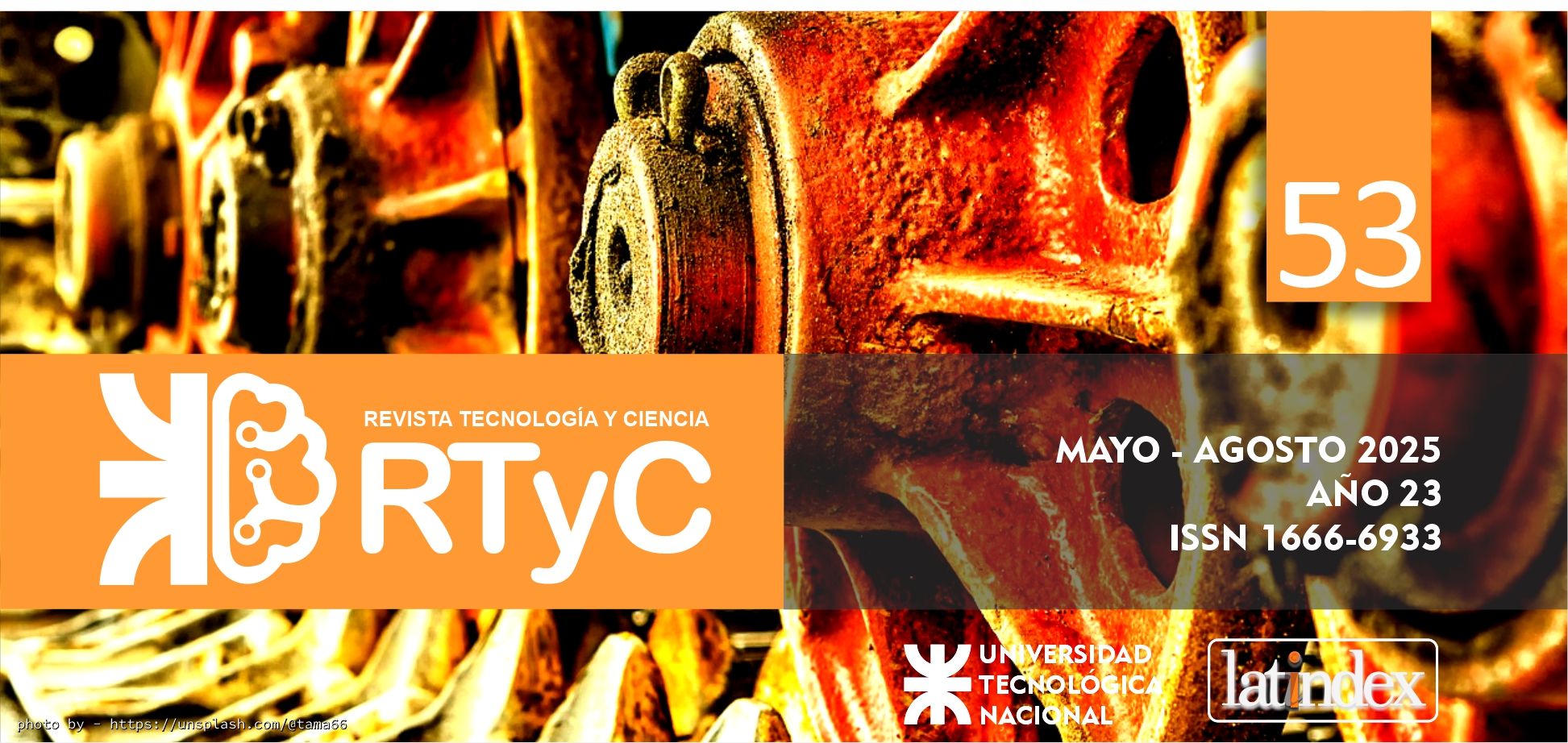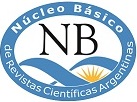Nanohorns de carbono de parede única como recipientes para hidrogênio molecular
DOI:
https://doi.org/10.33414/rtyc.53.15-25.2025Palavras-chave:
SWCNH, Nanoarmazenamento de H2Resumo
Nanochifres de carbono de parede única (SWCNHs) possuem propriedades únicas com grande potencial para aplicações nanotecnológicas. Entre seus potenciais usos futuros está o armazenamento estável de hidrogênio molecular (H2) em nanoescala. A interação entre SWCNHs e H2 pode ser estudada por meio de simulações atomísticas, que não apenas oferecem resultados comparáveis aos dados experimentais, mas também fornecem informações difíceis de serem obtidas por outros meios.
Em particular, a dinâmica molecular (DM) é fundamental, pois permite a análise da evolução de átomos e moléculas ao longo do tempo, fornecendo uma visão detalhada do movimento atômico e da termodinâmica do sistema. Neste trabalho, a DM com o código LAMMPS e o potencial reativo AIREBO são utilizados para examinar o comportamento de um SWCNH com um volume de aproximadamente 8 nm3, incluindo configurações com 38, 76, 152 e 304 moléculas de H2 em seu interior. A estabilidade do sistema, as estatísticas de energia e a topologia interatômica são avaliadas, além de determinar a pressão de H2 dentro dos SWCNHs em uma faixa de temperatura entre 200 K e 1000 K, encontrando uma boa concordância com resultados experimentais na fase gasosa.
Downloads
Referências
Almeida, E. R., De Souza, L. A., De Almeida, W. B., & Dos Santos, H. F. (2019). Molecular dynamics of carbon nanohorns and their complexes with cisplatin in aqueous solution. Journal of Molecular Graphics and Modelling, 89, 167-177. https://doi.org/10.1016/j.jmgm.2019.03.015
Arti, N., Alam, N., & Ansari, J. R. (2024). Nanostructures and fascinating properties of carbon nanohorns. En Handbook of Functionalized Carbon Nanostructures (pp. 351–389). Springer. https://doi.org/10.1007/978-3-031-32150-4_10.
Bhatt, M. D., Kim, H., & Kim, G. (2022). Various defects in graphene: A review. RSC Advances, 33, 1-15. https://doi.org/10.1039/D2RA01436J.
Chen, B.-H. (2014). Mechanical response of hydrogen-filled single-walled carbon nanotubes under torsion. International Journal of Hydrogen Energy, 39(3), 1382-1389. https://doi.org/10.1016/j.ijhydene.2013.10.121.
Chen, B.-H., & Kung, C. (2020). Quantum confinement and torsional responses of single-wall carbon nanotubes filled with hydrogen molecules. International Journal of Hydrogen Energy, 45(58), 33798-33806. https://doi.org/10.1016/j.ijhydene.2020.09.092.
Chen, G., Peng, Q., Mizuseki, H., & Kawazoe, Y. (2010). Theoretical investigation of hydrogen storage ability of a carbon nanohorn. Computational Materials Science, 49(4, Supplement), S378-S382. https://doi.org/10.1016/j.commatsci.2009.12.013.
Crespo, E. A., Braschi, F. U., & Bringa, E. M. (2018). Almacenamiento de H₂ a escala nanométrica: Un estudio por dinámica molecular. Rumbos Tecnológicos, 10, 45-60. https://rumbostecnologicos.utnfrainvestigacionyposgrado.com/volumenes/rumbos-10/almacenamiento-de-h2-a-escala-nanometrica-un-estudio-por-dinamica-molecular/
Comisso, N., Berlouis, L. E. A., Morrow, J., & Pagura, C. (2010). Changes in hydrogen storage properties of carbon nano-horns submitted to thermal oxidation. International Journal of Hydrogen Energy, 35(17), 9070-9081. https://doi.org/10.1016/j.ijhydene.2010.06.034.
Dubyey, L., Ukrainczyk, N., Yadav, S., Izadifar, M., Schneider, J. J., & Koenders, E. (2024). Carbon nanotubes and nanohorns in geopolymers: A study on chemical, physical and mechanical properties. Materials & Design, 240, 112851. https://doi.org/10.1016/j.matdes.2024.112851.
Dethan, J. F. N., & Swamy, V. (2022). Mechanical and thermal properties of carbon nanotubes and boron nitride nanotubes for fuel cells and hydrogen storage applications: A comparative review of molecular dynamics studies. International Journal of Hydrogen Energy, 47(59), 24916-24944. https://doi.org/10.1016/j.ijhydene.2022.05.240.
Fresco-Cala, B., López-Lorente, Á. I., & Cárdenas, S. (2018). Monolithic solid based on single-walled carbon nanohorns: Preparation, characterization, and practical evaluation as a sorbent. Nanomaterials, 8(6), 370. https://doi.org/10.3390/nano8060370.
Liao, R.-Z., Wei, S., Yi, W.-J., Chen, J.-H., & Yue, X.-Z. (2025). Synergistic effect of RuNi alloy supported by carbon nanohorns for boosted hydrogen evolution from ammonia borane hydrolysis. Journal of Colloid and Interface Science, 690, 137264. https://doi.org/10.1016/j.jcis.2025.137264.
Liu, X., Ying, Y., & Ping, J. (2020). Structure, synthesis, and sensing applications of single-walled carbon nanohorns. Biosensors and Bioelectronics, 167, 112495. https://doi.org/10.1016/j.bios.2020.112495.
Iijima, S. (2002). Carbon nanotubes: past, present, and future. Physica B: Condensed Matter, 323(1–4), 1-5. https://doi.org/10.1016/S0921-4526(02)00869-4.
Iijima, S., Yudasaka, M., Yamada, R., Bandow, S., Suenaga, K., Kokai, F., & Takahashi, K. (1999). Nano-aggregates of single-walled graphitic carbon nano-horns. Chemical Physics Letters, 309(3–4), 165-170. https://doi.org/10.1016/S0009-2614(99)00642-9.
Kagkoura, A., Ojeda-Galván, H. J., Quintana, M., & Tagmatarchis, N. (2023). Carbon dots strongly immobilized onto carbon nanohorns as non-metal heterostructure with high electrocatalytic activity towards protons reduction in hydrogen evolution reaction. Small, 19(31), 2208285. https://doi.org/10.1002/smll.202208285.
Kowalczyk, P., Terzyk, A. P., Gauden, P. A., Furmaniak, S., & Kaneko, K. (2014). Toward in silico modeling of palladium–hydrogen–carbon nanohorn nanocomposites. Physical Chemistry Chemical Physics, 16(23), 11763-11769. https://doi.org/10.1039/C4CP01345J.
Nguyen, T. A., & Assadi, A. A. (2018). Smart nanocontainers: Preparation, loading/release processes and applications. Kenkyu Journal of Nanotechnology & Nanoscience, 4(S1), 1-6. https://doi.org/10.31872/2018/KJNN-S1-100101.
National Institute of Standards and Technology. (s.f.). NIST Chemistry WebBook. Recuperado el 22 de mayo de 2025, de https://webbook.nist.gov.
Pagura, C., Barison, S., Mortalò, C., Comisso, N., & Schiavon, M. (2012). Large scale and low cost production of pristine and oxidized single wall carbon nanohorns as material for hydrogen storage. Nanoscience and Nanotechnology Letters, 4(2), 160-164. https://doi.org/10.1166/nnl.2012.1308.
Pandit, J., Alam, M. S., Javed, M. N., Waziri, A., & Imam, S. S. (2023). Emerging roles of carbon nanohorns as sustainable nanomaterials in sensor, catalyst, and biomedical applications. En Handbook of Green and Sustainable Nanotechnology (pp. 1721-1747). Springer. https://doi.org/10.1007/978-3-031-16101-8_48.
Qi, Y., & Miyako, E. (2025). Multifunctional magnetic ionic liquid-carbon nanohorn complexes for targeted cancer theranostics. Small Science, 5(3), 202400640. https://doi.org/10.1002/smsc.202400640.
Rungnim, C., Faungnawakij, K., Sano, N., Kungwan, N., & Namuangruk, S. (2018). Hydrogen storage performance of platinum supported carbon nanohorns: A DFT study of reaction mechanisms, thermodynamics, and kinetics. International Journal of Hydrogen Energy, 43(52), 23336-23345. https://doi.org/10.1016/j.ijhydene.2018.10.211.
Serban, B. C., Bumbac, M., Buiu, O., Cobianau, C., Brezeanu, M., & Nicolescu C. (2018) Carbon nanohorns and their nanocomposites synthesis, properties and aplications. A concise review. Annals of the Academy of Romanian Scientists Series on Science and Technology of Information Volume 11, Number 2/2018. https://www.researchgate.net/publication/329782184.
Serban, B. C., Buiu, O., Dumbravescu, N., Brezeanu, M., Cobianu, C., Bumbac, M., & Nicolescu, M. (2024). Some considerations about the sensing mechanisms and electrical response of carbon nanohorns–based gas sensors. Romanian Journal of Information Science and Technology, 27(2), 137-150. https://doi.org/10.59277/ROMJIST.2024.2.02.
Shi, K., Smith, E. R., Santiso, E. E., & Gubbins, K. E. (2023). A perspective on the microscopic pressure (stress) tensor: History, current understanding, and future challenges. The Journal of Chemical Physics, 158(4), 040901. https://doi.org/10.1063/5.0132487.
Stuart, S. J., Tutein, A. B., & Harrison, J. A. (2000). A reactive potential for hydrocarbons with intermolecular interactions. The Journal of Chemical Physics, 112(14), 6472-6486. https://doi.org/10.1063/1.481208.
Thompson, A. P., Aktulga, H. M., Berger, R., Bolintineanu, D. S., Brown, W. M., Crozier, P. S., in ‘t Veld, P. J., Kohlmeyer, A., Moore, S. G., Nguyen, T. D., Shan, R., Stevens, M. J., Tranchida, J., Trott, C., & Plimpton, S. J. (2022). LAMMPS - a flexible simulation tool for particle-based materials modeling at the atomic, meso, and continuum scales. Computer Physics Communications, 271, 108171. https://doi.org/10.1016/j.cpc.2021.108171.
Vijayaraghavan, V., Dethan, J. F. N., & Gao, L. (2019). Torsional mechanics of single walled carbon nanotubes with hydrogen for energy storage and fuel cell applications. Science China Physics, Mechanics & Astronomy, 62, 34611. https://doi.org/10.1007/s11433-018-9270-7.
Vijayaraghavan, V., Dethan, J. F. N., & Garg, A. (2018a). Nanomechanics and modelling of hydrogen stored carbon nanotubes under compression for PEM fuel cell applications. Computational Materials Science, 146, 176-183. https://doi.org/10.1016/j.commatsci.2018.01.041.
Vijayaraghavan, V., Dethan, J. F. N., & Garg, A. (2018b). Tensile loading characteristics of hydrogen stored carbon nanotubes in PEM fuel cell operating conditions using molecular dynamics simulation. Molecular Simulation, 44(9), 736-742. https://doi.org/10.1080/08927022.2018.1445246.
Zehra, S., Mobin, M., Aslam, R., & Bhat, S. U. I. (2023). Nanocontainers: A comprehensive review on their application in the stimuli-responsive smart functional coatings. Progress in Organic Coatings, 176, 107389. https://doi.org/10.1016/j.porgcoat.2022.107389.
Xie, Z., Lu, S., Peng, H., Liu, Y., Chen, J., Zhang, D., Liu, Y., Yang, B., & Liang, F. (2024). Regulating the structure of single-walled carbon nanohorns for impedance matching and electromagnetic wave absorption. ACS Applied Nano Materials, 7(22), 25921–25930. https://doi.org/10.1021/acsanm.4c05090.
Zhou, L. G., & Shi, S. Q. (2002). Molecular dynamic simulations on tensile mechanical properties of single-walled carbon nanotubes with and without hydrogen storage. Computational Materials Science, 23(1–4), 166-174. https://doi.org/10.1016/S0927-0256(01)00233-6.
Publicado
Como Citar
Edição
Seção
Licença
Copyright (c) 2025 Eduardo Ariel Crespo, Juan Manuel González, Mirtha Azucena Orozco, Eduardo Marcial Bringa

Este trabalho está licenciado sob uma licença Creative Commons Attribution-NonCommercial 4.0 International License.



















